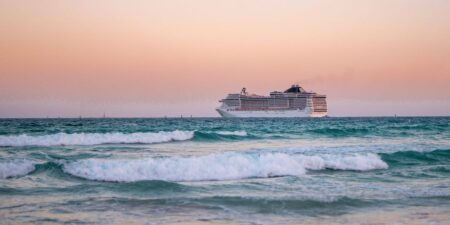X
Copy link
Impact Link
Save
Saved
Read in app
subscribers. Become an Insider
and start reading now.
Have an account? .
- I took the Lake Express ferry across Lake Michigan from Milwaukee to Muskegon, Michigan.
- I booked the premier cabin tier for $279, but ended up driving home because I got so seasick.
- I didn’t get to enjoy perks like more spacious seating or table service that came with my ticket.
As I looked up at the ceiling of the Lake Express ferry, lying on the floor while cradling a barf bag, I realized I’d made a mistake.
I grew up boating on smaller lakes around Wisconsin, so I thought I’d be fine on my ferry ride from Milwaukee to Muskegon, Michigan. After all, I was cutting my travel time in half by crossing the lake instead of driving through four states.
I didn’t anticipate that as the fifth-largest lake in the world, Lake Michigan’s waves can be just as powerful as the open seas. I’d splurged on a premier cabin ticket, but felt so seasick that I wasn’t able to enjoy the perks.
I did enjoy some parts of the journey despite my motion sickness, but I definitely came away from the experience knowing that I’m not cut out for cruises.
Follow along on my Lake Express ferry trip across Lake Michigan.
Lake Express did not respond to a request for comment.
The Lake Express ferry transports passengers across Lake Michigan between Milwaukee and Muskegon, Michigan, in half the time it takes to drive.
Instead of driving around the lake, which can take about 4 ½ to five hours, the Lake Express ferry brings passengers and their cars across the water in about 2 ½ hours.
An adult round-trip ticket starts at $199 for the classic cabin and $245 for the higher-tier premier cabin. To bring a vehicle along as well, round-trip tickets start at $236 on top of the passenger fees.
I paid a total of $279 for my round-trip premier ticket without a vehicle, including taxes and additional fees.
I arrived at the Milwaukee ferry terminal for my 6 a.m. trip to Muskegon, which was scheduled to arrive at 9:30 a.m. local time.
Michigan’s eastern time zone is an hour ahead of Wisconsin. Even though the trip only took 2 ½ hours, the time difference meant we’d lose an hour on the way.
When I checked in at security, the guard handed me a motion-sickness pill. That was the first red flag.
I’d checked the National Weather Service’s Great Lakes Portal and found that waves were expected to be around 1 foot high throughout the journey, which didn’t sound that bad.
Receiving free motion-sickness medicine immediately upon checking in made me feel a bit concerned about how choppy the waters would actually be. I took the pill to be safe.
All passengers waited in the same area, regardless of cabin class.
Unlike the Amtrak lounges available to first-class train passengers, there was no separate waiting area for those with premier cabin ferry tickets.
The waiting area featured free coffee for all passengers, a perk not usually offered on flights or trains.
There were also drinks, snacks, and souvenirs available for purchase.
When it was time to board, the lounge led straight out onto the dock.
An announcement told those traveling with cars to board first by driving their vehicles onto the ferry.
I was surprised by how spacious the classic cabin was compared to trains and planes that I’ve traveled on.
The classic cabin was laid out in clusters of eight seats around two tables, with a few tables on the edges ending up with more space.
Screens around the ferry showed the route, weather, and live feed of the outside.
The screens appeared in both cabins, showing our approximately 82-mile journey across Lake Michigan.
The concession stand was located at the front of the cabin for easy access to food and drinks.
Next to the checkout counter, condiment packets and plastic utensils were available for passengers to grab for themselves.
There were even fake flower pots decorating the cabin.
The faux flowers added a whimsical touch to the ferry ride.
The premier cabin featured even more space to spread out, with four to six seats to each table.
The ferry wasn’t very crowded on my trip, so I got an entire table with four seats to myself.
The cabin included a cart with more free coffee.
There was also a screen with a credit card reader to order additional concessions.
Unlike in the classic cabin, each table came with a menu to order food and drinks while seated instead of waiting in a line at the counter.
Breakfast burritos cost $10 while sandwiches and pizzas ranged from $11 to $12. There was also alcohol available for purchase, including local beers such as New Glarus Spotted Cow and Miller Lite.
Outlets seemed hard to come by in both the classic and premier cabins.
Unlike newer plane and train models that have outlets at every seat, the Lake Express ferry only had outlets every few rows.
I enjoyed watching the sunrise on the lower deck as the crew prepared for our departure.
Even while docked, the up-and-down movement of the ship on the water felt stronger than I’d anticipated. I hoped that once we started moving, the motion would feel smoother.
I explored the upper deck as the boat pulled out of the terminal, but it was too cold to stay outside for very long.
A factor that likely contributed to my impending seasickness was that it was too cold for me to sit outside on the deck in the fresh air.
In true Midwest spring fashion, it was 44 degrees on that early May morning. Strong winds over the open water made it feel even colder once we started moving. I got a little bit queasy from the sensation of the boat pitching up and down, but focusing on the horizon and feeling the wind against my face kept it from getting worse.
I lasted about half an hour outside before I got too cold and returned to the warmth of the premier cabin.
The waves felt even stronger as the trip progressed, and my seasickness became debilitating.
The Lake Express crew was clearly well-trained and used to passengers becoming seasick. As soon as they saw me looking a little green, they provided me with ginger ale, ginger chews, saltines, anti-nausea wristbands, and sickness bags.
Even though I was having a rough time, I felt well taken care of.
On the bright side, the bathrooms were spacious and clean.
The bathroom looked similar to bathrooms I’d encountered on Amtrak, with a few additional touches like decorative tile and a trash can with a weighted lid to keep it closed as the boat rocked back and forth.
I’d been excited to enjoy the luxury of my premier seat. Instead, I spent most of the journey lying on the floor with a barf bag handy.
The premier cabin where I’d booked my seat was located in the back of the ferry, where the motion of the boat was stronger. I couldn’t last more than a few minutes there without feeling like I was going to throw up.
A crew member told me that lying on the floor in the middle of the boat would help me feel more like I was swinging in a hammock or rocking in a chair. It worked. Kind of.
I spent the next two hours regretting the money I’d spent on a seat I wasn’t even using, for perks that I didn’t feel well enough to enjoy.
Land ho! I felt better once I disembarked in Muskegon, but the nausea and dizziness lingered throughout the day.
I managed to keep a few plain applesauce packets down around lunchtime, but had no appetite to eat anything else for the rest of the day.
In Muskegon, I spent the afternoon at the USS Silversides Submarine Museum with newfound respect for the conditions that sailors endured.
The Lyft driver who drove me from the ferry terminal to the submarine museum was a US Navy veteran himself. He told me that enlisted sailors often got seasick, too, which made me feel less pathetic.
“Some people I served with were just lucky — didn’t get seasick at all, ate all of their meals,” he said. “And some walked around with buckets.”
When it came time to return home, I couldn’t bring myself to get back on the ferry. I rented a car and drove home instead.
After a few hours of fresh air and fascinating World War II history, some of the color returned to my cheeks. However, I knew if I got back on the ferry, I would immediately feel awful again. The mere thought of being tossed around by the waves on the journey home made my stomach churn.
Unfortunately, since it was less than 24 hours before my return trip, my ferry ticket home wasn’t refundable.
I shelled out $123.27 for a rental car from Muskegon’s tiny airport and hit the road.
The drive from Muskegon to Milwaukee took about 4 ½ hours, but it was worth it to me.
The route took me down the Michigan coast, across Indiana and Illinois, and back up into Wisconsin, totaling around 300 miles.
I returned my rental car in Milwaukee and resolved to appreciate Lake Michigan’s beauty from its shores in the future.
About one in three people experience motion sickness, and genetics are a determining factor, according to a 2015 study published in the Oxford University Press’ Human Molecular Genetics.
The simple truth is that some people get seasick and some don’t, and I do. Even though I took motion sickness medicine ahead of the trip, it wasn’t effective enough to quell my symptoms.
If you’re one of those lucky people who doesn’t get seasick, the Lake Express ferry is a great option to cut across Lake Michigan for a shorter, more scenic trip than driving.
If you’re a landlubber like me, learn from my mistakes. Don’t spring for the more expensive cabin. Check the weather and wave heights ahead of time. And keep your options open for your return trip in case you end up on the floor.
Read the full article here
















